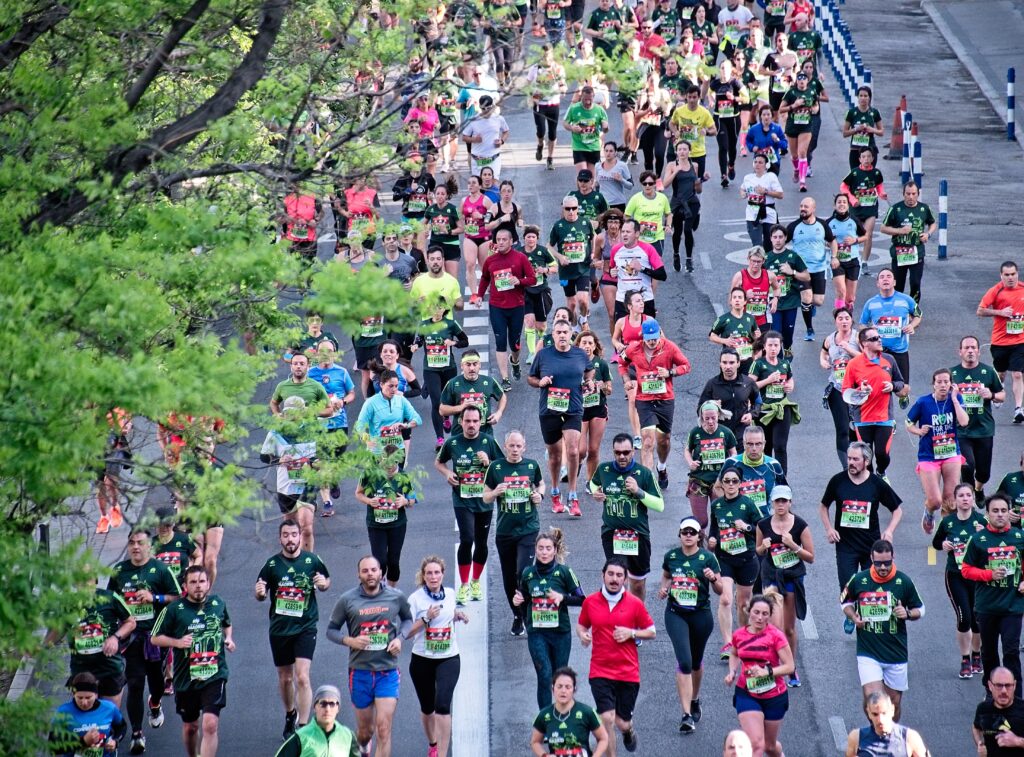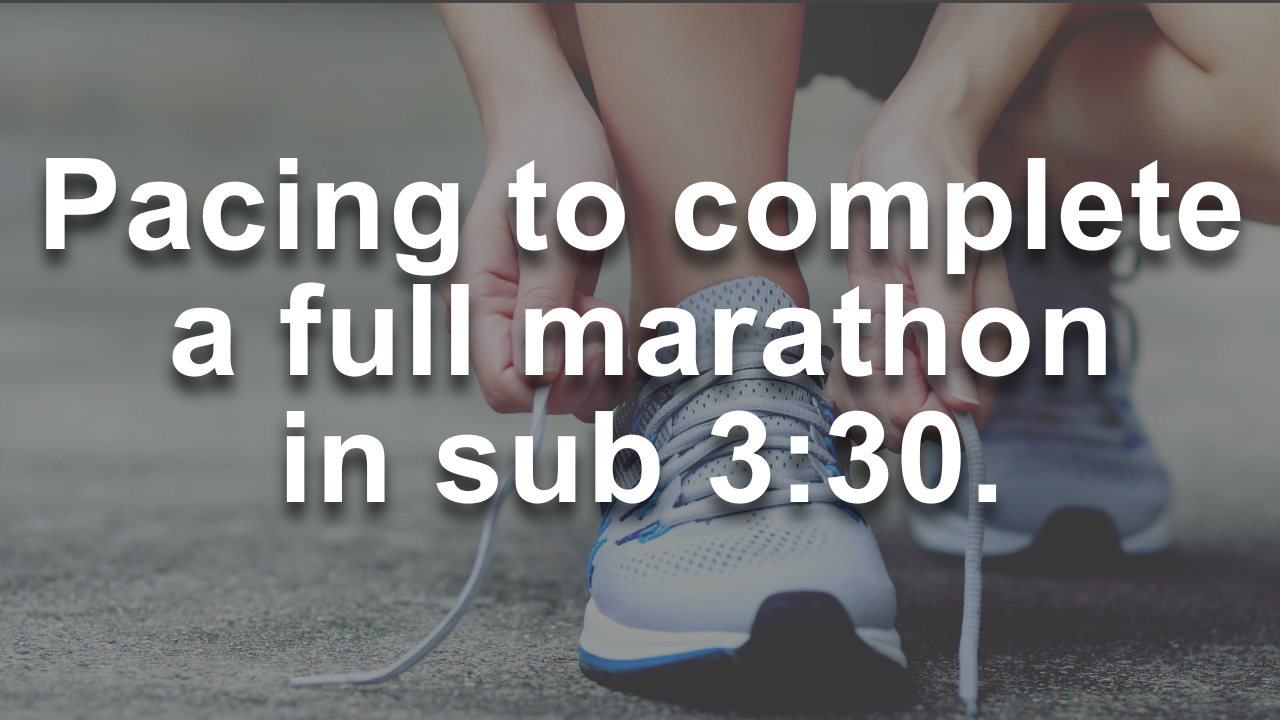
What is sub 3:30?
How do I get under 3 hours and 30 minutes for a full marathon?
How do I determine my pacing?
We can solve these problems.
Contents of this article
- What is sub 3:30
- Pace for a full marathon in less than 3 hours and 30 minutes
- Three types of pacing
Many people would like to run a full marathon at least once in their lives.
For the larger full marathon events, traffic regulations are enforced and the entire city takes on a festive atmosphere.

Just finishing a full marathon is enough to make you proud of your family and friends.
Some people not only want to finish the race, but they also want to improve on it and are concerned about their time.
There are two types of full marathon times: gross time and net time.
It is important to understand the difference between these two types of times.
If you don't already understand the difference, please read this first.
What is the difference between net time and gross time? Which is the official time?
Some of you may be wondering what percentage of those who have already completed a full marathon are in the top percentile.

This is a chart of the distribution of times for the Tokyo Marathon, one of the largest marathons in Japan.
As you can see, the top 15% of male finishers and the top 7% of female finishers complete the full marathon in less than 3 hours and 30 minutes.
Finishing a full marathon in less than 3 hours and 30 minutes is said to be sub 3:30, and it is said that you are an advanced runner.
It is a major hurdle that changes a runner from an intermediate runner to an advanced runner.
However, in order to break 3 hours and 30 minutes, you need to be aware of your pacing, not just run blindly.
So in this article, we will introduce three pacing strategies and pace settings to match them. Let's look at them in detail.
Three pacing
- Even pace (constant pace)
- Positive split (first half type)
- Negative split (second half)
More details will follow.
Also, if you have already achieved sub 3:30 and are aiming for sub 3 next, please click here.
Pacing to complete a full marathon in sub 3 (3 hours).
If you have read this far and feel that sub 3:30 is still too fast, why not start with sub 4?
Pacing to complete a full marathon in sub 4 (4 hours).
Let us explain in turn.
Contents
Even pace (constant pace)

It is to run at a constant pace, with the pace in the first half being the same as the pace in the second half. This is the ideal way to run because there are no ups and downs in pace.
Also, because you are always running at a constant pace, there is less strain on your legs. To achieve sub 3:30 in a full marathon, the required pace is 4 : 55 / km.
As a comparison, the table below shows the times when running at 4:45 / km and when running at 5:05 / km.
なりますよ。
| Pace | 4:45 / km | 4:55 / km | 5:05 / km |
| 5 km | 0:23:45 | 0:24:35 | 0:25:25 |
| 10 km | 0:47:30 | 0:49:10 | 0:50:50 |
| 15 km | 1:11:15 | 1:13:45 | 1:16:15 |
| 20 km | 1:35:00 | 1:38:20 | 1:41:40 |
| Half | 1:40:13 | 1:43:44 | 1:47:15 |
| 25 km | 1:58:45 | 2:02:55 | 2:07:05 |
| 30 km | 2:22:30 | 2:27:30 | 2:32:30 |
| 35 km | 2:46:15 | 2:52:05 | 2:57:55 |
| 40 km | 3:10:00 | 3:16:40 | 3:23:20 |
| Full | 3:20:26 | 3:27:28 | 3:34:29 |
Thus, when you run out at 4 : 45 / km, you can achieve sub 3:30 with ease, and when you run out at 5 : 05 / km, you cannot achieve sub 3:30. Therefore, 4 : 55 / km is the best you can do to achieve sub 3:30 at the minimum required pace.
I will also include the lap and passing times when you run out at 4 : 55 / km for reference.
| Pace | Lap | Transit time | |
| 5 km | 4:55 / km | 0:24:35 | 0:24:35 |
| 10 km | 4:55 / km | 0:24:35 | 0:49:10 |
| 15 km | 4:55 / km | 0:24:35 | 1:13:45 |
| 20 km | 4:55 / km | 0:24:35 | 1:38:20 |
| Half | 4:55 / km | 1:43:44 | |
| 25 km | 4:55 / km | 0:24:35 | 2:02:55 |
| 30 km | 4:55 / km | 0:24:35 | 2:27:30 |
| 35 km | 4:55 / km | 0:24:35 | 2:52:05 |
| 40 km | 4:55 / km | 0:24:35 | 3:16:40 |
| Full | 4:55 / km | 0:10:48 | 3:27:28 |
Thus, if you can run the full marathon in 4:55 / km, your time will be 3:27:28, which is an excellent sub 3:30 achievement.
However, if you are a full marathon beginner, it is difficult to run at a constant pace. Especially at the 30km mark, it is common for the legs to stop moving.
So here are some positive split to run faster in the first half of the race next.
Positive split (first half type)

The pace in the first half must be faster than in the second half. This is a way to make savings in the first half in anticipation of a slower pace in the second half.
Even professional runners find it difficult to run at an even pace, and their pace slows down in the second half due to fatigue.
For this reason, most beginner runners aiming for sub 3:30 will be this type of runner.
The ideal run for a positive split is to run the first 20 km at a pace of 4 : 35 / km in the first half of the race, and then run the second half at a pace of 5 : 15 / km in the second half when the legs are getting tired.
I will summarize the paces for your reference.
| Pace | Lap | Transit time | |
| 5 km | 4:35 / km | 0:22:55 | 0:22:55 |
| 10 km | 4:35 / km | 0:22:55 | 0:45:50 |
| 15 km | 4:35 / km | 0:22:55 | 1:08:45 |
| 20 km | 4:35 / km | 0:22:55 | 1:31:40 |
| Half | 5:15 / km | 1:37:26 | |
| 25 km | 5:15 / km | 0:26:15 | 1:57:55 |
| 30 km | 5:15 / km | 0:26:15 | 2:24:10 |
| 35 km | 5:15 / km | 0:26:15 | 2:50:25 |
| 40 km | 5:15 / km | 0:26:15 | 3:16:40 |
| Full | 5:15 / km | 0:11:31 | 3:28:11 |
I have also included my lap and passing times for reference.
If you can complete the full marathon at this pace, your time will be 3:28:11, which means you will achieve sub 3:30. It would be great if you can keep up the standard pace.
If you run too fast in the first half because you can afford it, you will often lose strength in the second half, your legs will stop moving, and you will stall out.
In fact, I myself have had the experience of getting carried away in the first half and running too fast, only to lose strength in the second half and end up walking at the end.
Therefore, we recommend the following negative split for beginners!
Negative split (second half)

The pace in the second half should be faster than the pace in the first half. A common pattern among beginners of full marathons is that they often run too fast in the first half and stall out in the second half.
Therefore, the method is to run the first half while conserving energy and then run faster in the second half.
The big advantage of this method is that many runners run out of energy in the second half and stall out. However, because you pick up the pace, you are able to overtake many people, which also improves your motivation.
The ideal positive split is to run the first 20 km at a slightly slower pace of 5 : 05 / km to conserve energy. In the second half of the race, it is recommended to run at a pace of 4 : 45 / km, using all remaining energy.
I will also include the lap and passing times for reference.
| Pace | Lap | Transit time | |
| 5 km | 5:05 / km | 0:25:25 | 0:25:25 |
| 10 km | 5:05 / km | 0:25:25 | 0:50:50 |
| 15 km | 5:05 / km | 0:25:25 | 1:16:15 |
| 20 km | 5:05 / km | 0:25:25 | 1:41:40 |
| Half | 4:45 / km | 1:46:53 | |
| 25 km | 4:45 / km | 0:23:45 | 2:05:25 |
| 30 km | 4:45 / km | 0:23:45 | 2:29:10 |
| 35 km | 4:45 / km | 0:23:45 | 2:52:55 |
| 40 km | 4:45 / km | 0:23:45 | 3:16:40 |
| Full | 4:45 / km | 0:10:26 | 3:27:06 |
If he can run the full marathon at this pace, he will achieve a time of 3:27:06, which is sub 3:30.
However, if you run too slowly in the first half of the marathon, you will not be able to make up the lost time in the second half. Even if you run slowly, you need to make up for it in the second half of the race.
This method is recommended for beginner runners, as they often lose strength at the beginning!
Summary
This article summarizes the following:
Three pacing
- Even Pace (Constant Pace)
- Positive split (first half type)
- Negative split (second half type)
Some people are more likely to skip the first half of the race, while others have the stamina to last until the second half, so please set a pace that suits you.

